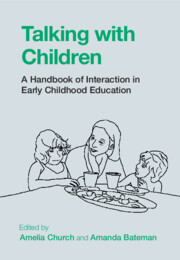Introduction
Published online by Cambridge University Press: 16 June 2022
Summary
This chapter provides an overview of how the Handbook contributes to a deeper understanding of teaching and learning interactions in early childhood education. To begin, we highlight the skillful work of teachers in their interactions with young children and the centrality of these interactions to learning and development. We then explain how research in conversation analysis serves as a professional learning resource for early childhood teachers, given the transparency and accessibility of the method and the illustrations of practice provided by transcripts of interactions in early learning environments. We also provide a brief overview of the wealth of studies in conversation analysis in early childhood and consider what this body of research contributes to our understanding of pedagogy. Finally, an overview of each chapter in this Handbook shows how recordings of teachers talking with children can reveal the distinct mechanisms of high-quality interactions and how these elements can be incorporated into everyday pedagogical practice in early childhood environments.
Keywords
- Type
- Chapter
- Information
- Talking with ChildrenA Handbook of Interaction in Early Childhood Education, pp. 1 - 18Publisher: Cambridge University PressPrint publication year: 2022



